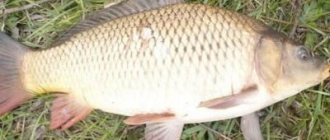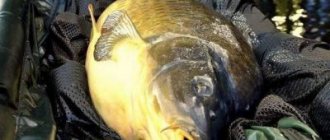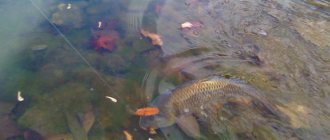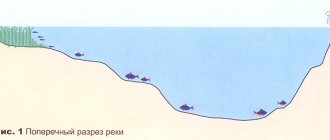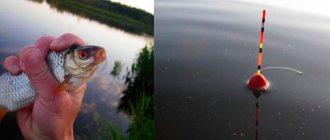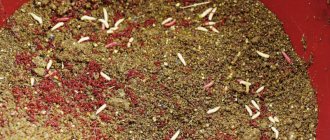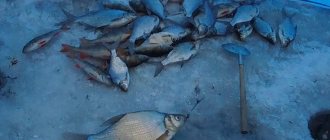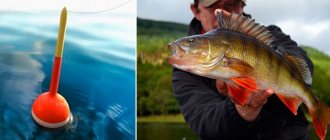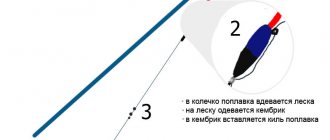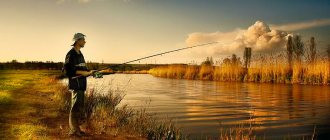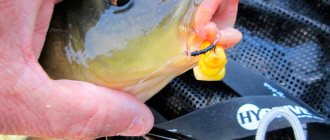When fishing fails during the day, carp fishing at night comes to the rescue. In the dark, there are bites from trophy fish, which lose their caution. But the fisherman faces a number of additional difficulties. Therefore, it is necessary to approach fishing responsibly, carefully assembling fishing rods and equipment. What are the main advantages of night fishing for carp?
Rationale for night fishing
With the arrival of summer, water in reservoirs becomes unevenly heated. The thermocline negatively affects underwater inhabitants who are looking for more comfortable water areas. During the day, anglers can enjoy watching huge fish swimming near the surface and basking in the sun. But they completely refuse to peck during daylight hours.
With the onset of twilight, the carp develops an appetite, and the fish begins to look for food in the bottom layer. The feast continues until the morning. It is quite difficult to guess the feeding time of carp in a particular reservoir. You have to sit near the fishing rods from late evening until the morning. Sometimes the bite begins after dark. Appetite may develop closer to midnight. Often a cunning fish grabs the bait when the angler is getting sleepy in the morning.
Many natural reservoirs are filled with swimmers in the summer heat. Of course, fishermen try to get away from the beaches. So, by nightfall, fish come to the areas where mass swimming took place. Here she finds a lot of easily accessible bugs and larvae. In addition, in bathing areas the water is well mixed and filled with oxygen.
Attention! Fishing for carp at night on beaches is very effective in reservoirs with a small concentration of large individuals.
Carp fishing at night
The peculiarity of carp fishing is that it is carried out around the clock. Often, carp are caught much better at night than during the day, and the likelihood of catching trophy specimens at a time when everything calms down and calms down increases significantly. Therefore, night fishing is an important part of carp fishing.
At the same time, catching carp at night greatly complicates the usual actions of the fisherman. which in daylight are carried out automatically and do not cause difficulties. To reduce the difficulties created by darkness to a minimum, it is necessary to properly prepare for night fishing.
Camp preparation
First of all, you need to carefully consider your routes of movement during night fishing and ensure that there are no obstacles on the way from the tent to the rods, from the rods to the place where you intend to fish, from this place to the carp mat, from the stand with the rods to the mounting table, on which you have to change leashes, attachments, etc.
This is a very important element of preparation for night carp fishing, since the adrenaline bubbling in the blood after a night awakening, combined with dull reflexes after a sudden awakening and darkness, can do a bad job. With a very high degree of probability, you simply will not notice the obstacle when running out of the tent to the rod-pod or carrying the trophy, which after a long struggle finally found itself in the landing net, to the carp mat, which can lead to quite serious injury, breakdown of expensive gear and other troubles, capable of hopelessly ruining fishing.
At night, it is especially important that any equipment that may be required during the fishing process is located in strictly designated places. This will help, firstly, to quickly find the right thing, and secondly, to avoid breakage, for example, of an expensive carbon cobra, which will certainly happen if you step on it in the dark.
Read: How to prepare for night fishing
Camp lighting
The success of carp fishing at night largely depends on the correct organization of lighting in key areas of the camp. Sometimes the timely execution of certain actions determines whether the treasured trophy ends up on the carp mat or floats past the fishing zone with impunity.
You can significantly simplify movement around the camp area at night by placing flashlights at key points. In the garden departments of construction supermarkets, sets of such flashlights cost pennies.
To facilitate the performance of various actions carried out inside the shelter (in a tent or marquee), it is advisable to organize lighting for the inside of the shelter. The easiest way to do this is with the help of special lamps, which are suspended at the top of the shelter using hooks or magnetic fasteners. It is very convenient if such a lamp automatically turns on after a bite and is controlled using a remote control.
Using special lamps on clothespins, you can organize additional local lighting of the mounting table.
Custom lighting fixtures
One of the most important pieces of equipment for night fishing is personal flashlights that leave your hands free. Such devices are attached either directly to the head using an elastic band (headlamps) or to the visor of a baseball cap (using plastic clips)
Models for baseball caps are very light, but since, with rare exceptions, they are powered by very compact batteries, they do not work for long from one set. Besides, on a cold night wearing a baseball cap doesn’t feel entirely comfortable. Headlamps are structurally monoblock and double-block. For two-block models, the batteries are placed in a separate block, which is mounted on the back of the head. It is very comfortable to walk in such a flashlight, since its mass is symmetrically distributed on the head. But these flashlights are not very suitable for the specific conditions of carp fishing. Firstly, sitting in a chair with a high back, when you try to tilt your head back, the battery pack puts very unpleasant pressure on the back of your head. Secondly, while waiting for a bite, you often have to sleep without taking off the flashlight; in this case, the block attached to the back of the head makes it difficult to sleep on your back. Therefore, the best choice, in my opinion, is a lightweight monoblock headlamp.
Read: Catching carp with a homemade boilie
Carp, seeing the light of a lantern, often, with the last of their strength, makes several desperate attempts to free itself from the hook, which often leads to disappearances at the landing net itself. To avoid this, at the final stage of fishing, it is better to use a flashlight with a red light; in this case, the carp behaves much calmer. Especially convenient are flashlights in which the red light is turned on not by pressing a button multiple times, but by using a quickly lowered filter. If you are not used to sleeping with a flashlight, keep it in a special organizer that is attached to the frame of the folding bed, then the flashlight will always be at hand, and you will not accidentally step on it.
The main advantage of night fishing is that at this time of day, carp, especially large ones, feed more boldly than during the day, and often come closer to the shore. There are frequent cases of catching night trophies just a few tens of meters from the shore. Therefore, at night it is imperative to maintain silence and try not to shine flashlights on the water unless absolutely necessary.
For night fishing, you can prepare in advance a special point located in a promising place in the coastal zone (both from your own and from the opposite bank). You should feed the night fishing zone using such noisy means of delivering bait as balls and rockets in advance, so as not to disturb the night rest of the pond. In the dark, it is better to feed using such almost silent means as a cobra tube and a slingshot (if the use of the latter allows the fishing distance).
Read: Bait balls for carp
It should be borne in mind that the preferences of fish can change dramatically during the day. This is partly due to changes in the activity of carp digestive enzymes. At some times of the day, enzymes that break down proteins are more active, and at others, they break down carbohydrates. In addition, bloodworms and other organisms that form the basis of the natural diet of carp are also subject to daily rhythms, which also affects the nutrition of the fish. Therefore, an attachment that worked perfectly during the day may completely lose its effectiveness at night. If this happens, try changing the bait to the opposite one (sweet to fish, and vice versa).
Fishing for carp at night can be very exciting and, with the proper approach, can bring many pleasant moments and joy from owning a trophy
Night fishing
Choosing a place and season
Photo 1. We choose a place before dark.
The key to success in carp fishing is the right choice of location. Of course, in some pay zones you can throw the tackle anywhere, and you won’t have to wait long for a bite. But in the natural environment, this type of fish prefers to move along the same paths. During the day, getting to them from the shore is problematic, but at night the carp visits feeding areas located in the coastal zone. At dusk you can see water lilies and reeds moving. Sometimes large fish come out to the shallows, showing their plump backs.
- In the dark, it is almost impossible to choose the right place for fishing in an unfamiliar body of water. Therefore, you need to arrive for fishing before dark in order to find changes in depth, interesting edges, and snags. Having delved into the study of the bottom relief, we should not forget about the coastal zone. If it is heavily overgrown with algae, then it is better to clean the bottom of branches, water lilies and other large contaminants.
- It is also necessary to prepare a workplace on the shore. Bushes and overhanging tree branches must be cut out so that they do not interfere with casting rigs or landing fish. You should also clear the path from the tent or car to the fishing rods, then when there is a bite, nothing will prevent you from quickly getting to the gear.
Carp can be caught well at night from the end of June until October. But at different times the fish feed at different points.
- During the summer, you can successfully fish near the shore, armed with float rods. The fishing depth can be about 1 m.
- In the fall, you have to use a feeder to deliver bait to distant points. Sometimes a match fishing rod comes to the rescue, allowing you to cast long distances.
The search for a promising drop or edge is carried out with a marker rod. If you don’t want to drag it to a pond, you can study the depth using a depth gauge on a match rig. But this method will not allow one to determine the nature of the soil. The density of the bottom surface can be easily determined using a feeder by attaching a sinker instead of a feeder. But the exact value of the depth cannot be determined.
Gear and equipment
For successful night fishing you will need two types of rods: a feeder and a match. Time will tell which of them will fire on a particular night. If an angler is aiming to catch a trophy carp, then it is necessary to take a carp rod. With such a set of gear, you can check all promising points on the reservoir.
The equipment of the fishing rods is selected taking into account the size of the possible catch. First of all, this concerns the type and thickness of the fishing line. A similar approach is required when choosing a hook. But certain adjustments must be made to each of the gear for night fishing.
- The feeder tackle is equipped with a firefly or an audible alarm to determine the moment of a bite. In the silence of the night, the sound of a falling feeder will alarm all underwater inhabitants. Therefore, it is better to feed the point before dark. And it is preferable to produce supplementary feeding using radio-controlled boats or slingshots.
- When trophy specimens live in a reservoir, it is better to arm yourself with a powerful carp fishing rod. It is equipped with a strong fishing line and one of the many accessories. The most commonly used bait is hair mounting.
- A match fishing rod is used at night at a distance of no more than 30 m. When casting far, the eyes quickly get tired of watching a small luminous point. The match also wins when the carp feeds not from the bottom, but in the middle layer.
Carp fishing technique and choice of baits
Both during the day and at night, the nutritional requirements of carp can change periodically. In order not to miss your prey, it is advisable to take several different attachments for fishing at once.
When fishing in overgrown areas of a reservoir with a shallow depth (up to half a meter), the method of fishing with a bread crust in a vertical line works well.
Other carp baits are also effective at night. The main condition for a good bite is to pre-feed the selected area of the reservoir.
Night carp fishing is a rather difficult and responsible activity. But the right approach, patience and enthusiasm will allow you to get an incredible adrenaline rush and unforgettable emotions.
Perhaps the upcoming night fishing will give you a chance to catch your first trophy. The main thing is not to miss this chance!
Features of feeding
For night fishing, the same baits that anglers use during the day are suitable. But with feeding tactics, not everything is so simple.
- The first difference is the smaller localization of the bait spot. This is due to several reasons. One of them is the difficulty in practice of sending bait to the same place in the dark. In the same way, it is problematic to cast the equipment perfectly. It’s good if there is a luminous landmark on the opposite bank. What if it’s pitch dark opposite?
- When using a slingshot or cobra to throw small portions of bait (boilies), it is important to determine and remember the angle of the shot. In a slingshot, the distance of retraction of the strands should also be noted.
- For match fishing, the feeding tactics are as follows. When starting feeding, it is necessary to put 3/4 of all bait into the water. During daylight hours, some of the bait is eaten by the ubiquitous small fish, but most of it goes to the carp that approaches at dusk. And additional feeding is done in the second half of the night, when the lack of biting has dragged on.
- With a feeder it is better to follow a different scheme. First, 1/3 of the bait is sent into the water. During the night, the working feeders should be periodically clogged and the rest of the feed should be added in small doses.
The process of night carp fishing
Since we are going to fish at different distances, we will use carp baits or powerful feeders, and float rods. We will cast the first ones at long distances, and the fishing rods at short distances. There is virtually no noise when casting a fishing rod. The long length of the rod allows you to catch even large specimens.
We install carp fish and feeders on rod pods or large tripods. If there are no such stands, then we place the rods on single stands at a distance of a meter from each other. We place fishing rods on single stands. You can cast two fishing rods and three donks.
You need to come to fishing well-rested. At night, carp can bite in different ways. In some cases it is active from 12 to 3 o'clock. In others, the pecking begins just before dawn. In the middle of summer, it is almost impossible to understand when the carp bite will begin. Therefore, you should stay near the fishing rods all night.
As an option, you can use a soft folding chair, which is comfortable to lie on, and put electronic alarms on the fishing rods. During a good bite, a loud sound should wake you up. But it’s better not to sleep. It happens that the number of bites can be 2-3. But these are bites from large fish. If you don’t hook it in time, the carp will get the tackle into snags or grass, and it will be impossible to get it out.
Of course, it can be difficult to sit all night waiting for bites. But you don't have to sit. You can vary your fishing a little. For example, catching another white fish with an elastic band. It is enough to step a little to the side and cast the tackle. Let the carp fishing rods be on the alarms at this time, and at this time you can quietly catch bream, crucian carp and roach. The main advantage of the elastic band is its noiselessness. All you need to do is quietly place the baits on the hooks and carefully send the elastic into the water.
It is very important to take aim before dark. It is necessary to remember the points where you should throw the feeders. To accurately hit the same place, we fix the fishing line on the spool with rubber bands. We mark the place of fixation with a bright marker. A meter of fishing line must be painted over. When casting, the line will go down to the fixation point. After sharp pulls, the line will be released by the clutch or baitrunner. The fishing line may slip off the elastic. To restore the previous range, we find a painted area of wattle or fishing line and place it under the elastic band on the spool.
In the evening, you should arrange everything correctly, repeatedly cast the gear, and fill your hand so that you can cast automatically at night.
If one of the points is in shallow water, then pay attention to whether there are bubbles on the surface of the water. Their presence is a sure sign that carp are present. As a rule, such zones are located near the coast. Fishing in such places is necessary only with a fishing rod. It must be powerful, have a front drag reel with a spool size of 5000.
If the shallow water area is located at a decent distance, then you should use a match fishing rod with a rigid action and a test weight of 10-20 g. This rod will allow you to make long and accurate casts.
It is clear that not everyone is able to make accurate casts at night. If you see that the tackle is lying to the right or left of the point, then use large PVA bags. This way you will be sure that a sufficient amount of bait is always present near the bait with a hook.
When fishing with fishing rods, we attach fireflies to the float. You can use a cambric or a transparent tube that comes with the fireflies.
A very effective tactic is to use different baits and baits on different fishing rods. Most often, this method is used when fishing in paid reservoirs. It happens that carp are caught only on corn in plum dip. Or it only bites on large boiled peas and feeds on pellets. Therefore, we put corn on one fishing rod, potatoes or barley on another, and boilies with different flavors on the third and fourth. A good option is a combination of corn and worm.
Be sure to adjust the clutch on each reel and if there is a baitrunner, then set it to the working position.
It happens that at first only one point works. For example, carp can only be caught well in shallow waters. This does not mean that it will continue to be so. We continue to fish at the same points. It often happens that after a few hours other points begin to work, and where there was a bite, everything calms down. All preparation should take place during daylight hours. You shouldn't change points at night. All you have to do is wait and try different dips and baits.
Lures
Carp is considered a finicky fish when it comes to feeding. Even during a short night, fish can change their preferences from animal food to plant food. Boilies have become one of the universal baits. Thanks to a wide range of aromas, it is possible to please the freshwater piglet. But you shouldn’t go fishing with boilies alone, even branded ones. The set should contain natural baits and freshly prepared baits.
Baits
The least wary of the cautious carp are the animal objects it feeds on in the pond. Most often these are bloodworms, leeches, shells, crustaceans and worms. While bloodworms and worms can be purchased at any fishing store, difficulties arise with other baits. Some experienced fishermen go out on a boat with nets to scoop up edible creatures from the bottom.
You can also take maggots with you. Today, blowfly larvae are sold both in natural colors and painted red. For night fishing this is not a decisive factor. The smell that the bait emits will be more important.
Nozzles
Vegetable baits work well from summer to early autumn. The choice of bait is determined by the regional preferences of the fish. It is useful to take canned corn, steamed peas, wheat and barley with you. There are many variations of the dough, to which different ingredients are added. In some reservoirs, carp prefer traditional mastyrka or makukha.
Choosing a bait for night fishing
It should be borne in mind that the preferences of fish can change dramatically during the day. This is partly due to changes in the activity of carp digestive enzymes. At some times of the day, enzymes that break down proteins are more active, and at others, they break down carbohydrates. In addition, bloodworms and other organisms that form the basis of the natural diet of carp are also subject to daily rhythms, which also affects the nutrition of the fish. Therefore, an attachment that worked perfectly during the day may completely lose its effectiveness at night. If this happens, try changing the bait to the opposite one (sweet to fish, and vice versa).
Fishing for carp at night can be very exciting and, with the proper approach, can bring many pleasant moments and joy from owning a trophy
Additional equipment
For night fishing you will need a certain set of special accessories. This additional equipment will make fishing safe, comfortable and effective.
- A necessary element for carp fishing will be a landing net. It must be roomy so as not to miss in the dark, thereby scaring the fish.
- Experienced fishermen pay special attention to lighting. If the camp can be illuminated with conventional LED devices, then the headlamp near the water should be equipped with a red filter. The carp reacts calmly to this spectrum of light radiation, and when fishing, the fish is not afraid.
Photo 2. A headlamp is a must at night. - Summer night is the time of little vampires who will attack the fisherman in large hordes. But in the cool of the night, you can protect most of the body with thick clothing, and apply some kind of spray or gel to exposed areas. In a camp or tent, you can repel mosquitoes with smoldering coils.
